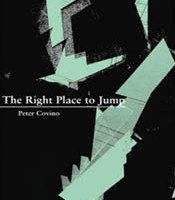It’s been three quarters of a decade since the 2005 publication of Peter Covino’s first book of poems, Cut Off the Ears of Winter, but Covino picks up right where he left off, only with more self-assurance and a broader range of subject matter. If Cut Off the Ears of Winter made clear that Covino was a poet to be reckoned with, a writer who ably mines autobiography for both universal truths and private moments of pain and beauty, than surely Covino’s second collection, The Right Place to Jump, cements his status as such.
The Right Place to Jump is deceptively slim in appearance. This is a book that is far-reaching in every way that matters—Covino is unafraid to be here formal, there experimental, here precise and there abstract. While family is still present—especially the figure of the mother—the father no longer dominates as he did in Cut Off the Ears of Winter. And good riddance, as both Covino and his poems feel less encumbered for it.
Covino has an uncanny ability to speak plainly and profoundly in the same breath. Consider one of the book’s smallest poems, “Heroin”:
Last night the snow filled up your arms
tracks of snow from East 2nd Street &
I couldn’t dig out your Porsche replace
the curtains in ample free time
paint the changes of the window in the light
little of nothing to hold on to
how the skin peels away the bugs
come apart with mayonnaise & honey
Short though it may be, these eight lines draw the reader in wholly. The immediacy is tangible, the ache evident in the rich details. The white space that separates each line from the next allows for a quick but necessary pause, offering the reader a breath to fully consider what’s just been presented before continuing on. The concrete specificity of images offers comfort even as the images themselves do the exact opposite.
Throughout The Right Place to Jump, Covino employs spacing and structure as carefully as he does in “Heroin”. This is a poet who thinks about form before breaking with it, a poet who is paying attention to the shape of his words on the page. Even when he leaves behind form altogether, as in the second part of “Mise-en-scène,” the echo of form remains.
Another example of Covino’s attention to form is found in “The River.” In this longer poem, Covino utilizes sharp line breaks combined with indentation to help move the reader between lush dream memories (“In the dream of the river, the sound of water/Rushing, water roaring: sounds/Like animal sounds, human sounds, both: You have loved me too well and not enough…”) and more immediate, harsher recollections that feel more part of reality than part of dreamscape (My mother sometimes fought back,/But she’d bruise easily/& lie to her Chinese co-workers/At the dress shop;”). The poem snakes forward in this back-and-forth fashion, taking on the literal shape of a river, as the reader is pushed between dream and memory. The words are primary, but the formatting is never just an afterthought.
Nearly every poem in The Right Place to Jump is personal; the reader is invited to share intimately in Covino’s life history. Covino’s reader is a spectator, but an engaged one. In “Eternal Mercy Hallmark Card,” we are there with Covino at the veterinarian’s office as he watches his cat being put to sleep. The poem couldn’t be more specific—we are given the veterinarian’s name, the cat’s name, and are drawn into Covino’s immediate grief with lines like “Please/don’t put my cat/in a plastic bag.” And yet, as individual as the situation is, the grief is universal. The pain is as accessible as it is visceral.
This is the power of Covino’s kind of poetry—that the individual experience confirms the connectedness of humanity. That our shared emotion, when expressed in certain words, allows a reader to relate to that which he or she has never directly faced. Covino explores his own sexuality, his own tragedies and losses, his own family, in such a way that the reader is exploring him or herself alongside Covino, through the lens of Covino’s experiences, as laid bare by his words.



